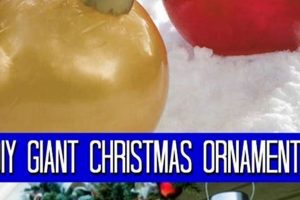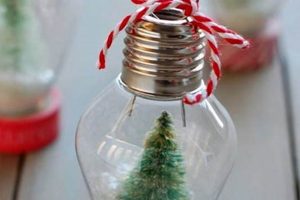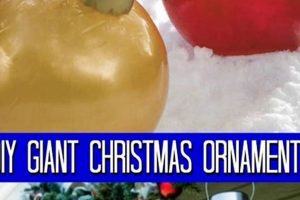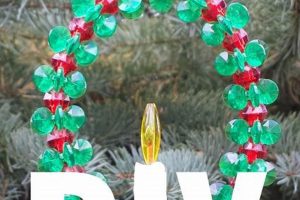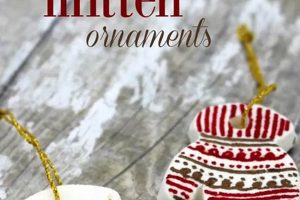Handcrafted fabric decorations designed for the Christmas season constitute a popular form of seasonal crafting. These decorations frequently employ felt as the primary material and are created by individuals at home, following instructions or original designs. A typical example includes a star-shaped decoration sewn from red and green felt, embellished with embroidered details and hung on a Christmas tree.
The creation of personalized holiday adornments offers numerous advantages. It provides a cost-effective alternative to commercially produced decorations, enabling significant savings. Furthermore, this activity encourages creativity and allows for the production of unique, sentimental items. Historically, crafting homemade decorations has been a tradition passed down through generations, fostering family bonding and preserving cultural heritage.
Subsequent sections will delve into specific techniques for constructing these ornaments, explore diverse design options, and offer guidance on selecting appropriate materials and tools for successful execution.
Tips for Crafting Fabric Holiday Decorations
Effective construction of felt Christmas decorations requires careful planning and precise execution. Adherence to the following guidelines will improve the quality and longevity of the finished items.
Tip 1: Material Selection: Opt for high-quality felt. Wool or wool-blend felt offers superior durability and color retention compared to synthetic alternatives. The density and thickness of the felt will impact the final appearance and structural integrity of the ornament.
Tip 2: Pattern Precision: Employ accurate patterns. Freehand cutting can lead to inconsistencies. Utilize templates, either purchased or self-drafted, ensuring uniform shapes and sizes for all components.
Tip 3: Stitch Selection: Choose appropriate stitching techniques. A blanket stitch provides a clean, decorative edge while securing the felt layers. Backstitch is suitable for adding finer details and embroidery. Inconsistent stitching can compromise the visual appeal and structural strength.
Tip 4: Embellishment Restraint: Exercise moderation in embellishment. Overloading with beads, sequins, or glitter can detract from the overall design and increase the risk of detachment. Secure embellishments meticulously using appropriate adhesives or stitches.
Tip 5: Secure Fastenings: Utilize durable hanging loops. Thin thread or flimsy ribbon can break easily. Employ a robust cord or wire securely attached to the ornament’s top to ensure safe and reliable display.
Tip 6: Proper Stuffing: Use appropriate stuffing materials. Polyester fiberfill is lightweight, washable, and retains its shape well. Avoid overstuffing, which can distort the ornament’s form. Distribute the stuffing evenly to prevent lumps or unevenness.
Tip 7: Storage Considerations: Store decorations properly to preserve their condition. Wrap each ornament individually in acid-free tissue paper and store them in a sealed container in a cool, dry place to prevent damage from dust, moisture, or pests.
By prioritizing material quality, pattern accuracy, and meticulous construction techniques, individuals can create enduring and visually appealing felt Christmas decorations. These careful steps will ensure these decorations can be enjoyed for many holiday seasons.
The following sections will provide detailed instructions on specific ornament designs and advanced crafting techniques.
1. Material Selection
The choice of materials directly impacts the final quality, durability, and aesthetic appeal of felt Christmas ornaments. Inadequate material selection can lead to ornaments that are prone to damage, lack visual appeal, or have a short lifespan. For example, using low-quality acrylic felt results in a less vibrant color palette and a tendency for the ornament to pill or lose its shape over time. Conversely, selecting high-quality wool felt provides superior color retention, a softer texture, and increased resistance to wear and tear. This demonstrates a clear cause-and-effect relationship, where the input (material selection) directly determines the output (ornament quality).
Beyond the basic felt material, embellishments and thread choices are also crucial. Using inexpensive, brittle beads can result in breakage and detachment, diminishing the ornament’s appearance. Selecting durable, fade-resistant embroidery floss ensures that decorative details remain vibrant over successive holiday seasons. Furthermore, the type of stuffing material significantly affects the ornament’s shape and feel. Cotton stuffing, for instance, can become lumpy and lose its form when exposed to moisture, whereas polyester fiberfill maintains its loft and shape even after repeated use.
Therefore, material selection is not merely a preliminary step but a foundational element in crafting successful felt Christmas ornaments. Careful consideration of material properties and their impact on the final product is essential. Prioritizing quality materials may increase the initial cost but ultimately yields ornaments that are more aesthetically pleasing, durable, and retain their value as cherished keepsakes over extended periods. The challenge lies in balancing cost considerations with the desire for long-lasting, visually appealing decorations.
2. Pattern Design
Pattern design is integral to the successful execution of handcrafted fabric holiday decorations. The pattern serves as the foundational blueprint, dictating the ornament’s shape, size, and complexity. A poorly designed pattern can result in an ill-proportioned, asymmetrical, or structurally unsound ornament. Conversely, a well-crafted pattern provides precise outlines and clear markings, streamlining the cutting and assembly processes. For instance, a pattern for a star-shaped ornament with uneven points will inevitably yield a finished product that lacks visual appeal, whereas a meticulously designed star pattern with accurate angles ensures a symmetrical and aesthetically pleasing result. Thus, the pattern design directly impacts the visual quality and overall success of the completed craft project.
The choice of pattern complexity should align with the crafter’s skill level. Simple patterns, featuring basic shapes and minimal embellishments, are suitable for beginners. These designs typically involve fewer pieces and straightforward stitching techniques. More intricate patterns, incorporating detailed shapes, multiple layers, and advanced embroidery, cater to experienced crafters. Selecting a pattern that exceeds one’s capabilities can lead to frustration and a substandard final product. Furthermore, the pattern dictates the quantity and dimensions of required materials. Accurate pattern measurements prevent material wastage and ensure sufficient fabric for all ornament components.
In conclusion, pattern design is not merely a preliminary step in the process, but a crucial determinant of the quality and success of handmade festive fabric ornaments. Attention to pattern accuracy, complexity, and material requirements is paramount. The pattern acts as a guide through the crafting process, affecting the visual form and structural integrity of the decoration. Choosing an appropriate pattern is a critical decision when making fabric decorations, affecting the project outcome in a significant and noticeable manner.
3. Stitching Technique
Stitching technique plays a pivotal role in the structural integrity, aesthetic appeal, and overall longevity of handcrafted fabric holiday ornaments. The selection and execution of appropriate stitches directly influence the ornament’s durability, detail, and visual quality.
- Blanket Stitch: Edge Stabilization and Decorative Finish
The blanket stitch serves primarily to secure the edges of felt pieces, preventing fraying and providing a clean, finished border. Employed along the perimeter of an ornament, the blanket stitch not only joins the front and back pieces but also adds a decorative element. The regularity and spacing of the stitches contribute significantly to the ornament’s visual appeal. For example, an evenly spaced, tightly executed blanket stitch can elevate a simple star-shaped ornament, whereas an uneven or loosely executed stitch can detract from its overall appearance.
- Running Stitch: Efficient Assembly and Quick Detailing
The running stitch is a basic, versatile stitch used for quickly assembling components and creating simple details. This stitch is suitable for joining layers of felt or adding basic embellishments. While less robust than other stitch types, its speed and simplicity make it ideal for initial assembly or tacking elements in place before applying more secure stitches. A running stitch can outline a simple shape or secure a small decorative element, such as a sequin or bead, onto the ornament’s surface.
- Backstitch: Precision and Definition for Intricate Details
The backstitch provides enhanced control and precision when creating intricate details or outlining complex shapes. This stitch is characterized by its closely spaced, overlapping stitches, resulting in a solid line that enhances the visibility of intricate designs. Using backstitch to define the edges of a felt applique or add detailed embroidery to a character on an ornament adds a professional and polished look.
- Whip Stitch: Secure Seams and Invisible Joins
The whip stitch provides a relatively invisible seam for joining felt pieces. Unlike the blanket stitch, which is designed to be visible, the whip stitch is ideal for situations where a clean, uninterrupted surface is desired. When joining two pieces of felt to create a three-dimensional ornament, careful execution of a whip stitch minimizes the appearance of the seam and gives the ornament a smooth, seamless appearance.
The selection of appropriate stitching techniques directly influences the durability, aesthetic quality, and detail of felt Christmas ornaments. Mastery of these stitching techniques provides the foundation for crafting visually appealing and structurally sound ornaments capable of withstanding handling and repeated use during the holiday season. The craftsmanship exhibited in the stitching significantly affects the overall success and value of these decorative items.
4. Embellishment Choices
The selection and application of embellishments are fundamental to the aesthetic impact and perceived value of handcrafted fabric holiday ornaments. These additions transform basic felt shapes into personalized and visually engaging decorations, contributing significantly to their appeal.
- Beads and Sequins: Adding Texture and Sparkle
Beads and sequins provide opportunities to introduce texture, dimension, and reflectivity to felt ornaments. Glass beads, available in a wide range of colors and sizes, can be sewn individually or in clusters to create intricate patterns. Sequins, with their inherent shimmer, add a touch of elegance and festivity. However, the selection of appropriate sizes and secure attachment methods are critical. Overuse or insecure attachment can detract from the overall design and lead to premature loss of embellishments. For example, small seed beads can be used to create a delicate border around a felt snowflake, while larger sequins can be strategically placed on a felt reindeer to simulate sparkling antlers.
- Embroidery Floss: Defining Details and Adding Color
Embroidery floss offers a versatile medium for adding fine details, outlining shapes, and incorporating color to felt ornaments. Different stitching techniques, such as backstitch, satin stitch, and French knots, allow for the creation of intricate patterns and textures. Embroidery can be used to personalize ornaments with names, dates, or festive messages. The quality of the embroidery floss is a significant factor; using colorfast and durable floss prevents fading and ensures long-lasting visual appeal. Embroidering a name on a heart ornament or adding detailed stitching to a felt snowman demonstrates the personalized impact.
- Ribbons and Trims: Introducing Texture and Dimension
Ribbons and trims offer diverse textures and dimensional elements to felt ornaments. Satin ribbons, grosgrain ribbons, and decorative braids can be strategically applied to enhance visual interest and create a sense of depth. Ribbons can be used to create hanging loops, decorative bows, or layered effects. Careful color coordination and secure attachment are essential to prevent the embellishments from overpowering the overall design. A velvet ribbon bow on a felt angel or decorative braid trimming the edge of a felt stocking exemplifies the effective use of ribbons and trims.
- Buttons: Adding Character and Whimsy
Buttons can bring a touch of whimsy and character to felt ornaments. The variety of shapes, sizes, and colors available makes buttons a versatile embellishment. Small buttons can be used as eyes for felt animals, while larger buttons can serve as decorative accents on felt snowmen or Christmas trees. The secure attachment of buttons is vital to prevent them from detaching and posing a potential hazard. Using shank buttons, which have a loop on the back for sewing, provides a more secure attachment compared to flat buttons with holes. Attaching colorful buttons to a felt gingerbread man or using antique buttons on a vintage-style ornament showcases the unique and personal impact.
Ultimately, the effective use of embellishment choices transforms basic felt shapes into cherished decorative objects. Thoughtful selection, careful application, and attention to detail elevate these handcrafted items from simple crafts to treasured keepsakes. The balance between material quality, design integration, and secure attachment is critical for producing durable and visually appealing fabric Christmas ornaments that enhance the festive atmosphere.
5. Stuffing Material
The selection of stuffing material exerts a considerable influence on the final form, texture, and overall quality of handcrafted fabric holiday ornaments. The stuffing directly affects the three-dimensional shape, structural stability, and perceived value of these decorations. Inadequate stuffing material can result in misshapen ornaments lacking visual appeal and structural integrity. Conversely, appropriate stuffing choices enhance the aesthetic appeal and tactile quality of the finished product. For instance, ornaments stuffed with insufficient material appear limp and lack definition, while overstuffed ornaments become distorted and lose their intended form. Proper stuffing distribution avoids lumpiness and ensures a smooth, uniform surface.
Practical considerations extend to the longevity and maintenance of these decorative items. Cotton stuffing, while initially economical, exhibits a propensity to absorb moisture, leading to potential mildew growth and distortion over time. This can degrade the ornament’s appearance and compromise its structural integrity. In contrast, polyester fiberfill offers superior moisture resistance, maintaining its loft and shape even after prolonged use or exposure to humid conditions. Furthermore, polyester fiberfill is washable, enabling easy cleaning and preservation of the ornament’s aesthetic appeal. The choice of stuffing material, therefore, involves a trade-off between initial cost and long-term performance, influencing the ornament’s lifespan and maintenance requirements.
In summary, the selection of stuffing material represents a critical decision point in the creation of fabric festive decorations. Careful consideration of the material’s properties, including its density, moisture resistance, and washability, is essential for ensuring both the immediate aesthetic appeal and the long-term durability of these cherished keepsakes. The appropriate choice can contribute significantly to the value and longevity of the handcrafted holiday ornaments, while a poor choice can lead to their rapid degradation.
6. Hanging Mechanism
The hanging mechanism, while seemingly a minor component of do-it-yourself felt Christmas ornaments, represents a critical element directly impacting the ornament’s functionality and display. The effectiveness of the hanging mechanism determines whether the handcrafted ornament can be securely and attractively showcased on a Christmas tree or other holiday display. A poorly constructed or inadequately attached hanging mechanism renders the ornament unusable, negating the effort invested in its creation. For instance, a thin, easily broken thread loop can cause an ornament to fall and potentially break, especially if the ornament is heavy or adorned with delicate embellishments. Conversely, a sturdy, well-secured hanging mechanism ensures the ornament remains safely suspended, contributing to the overall aesthetic of the holiday display.
The selection of materials and attachment methods for the hanging mechanism significantly influences its durability and longevity. Simple thread loops, while easy to create, are often prone to breakage, particularly with repeated use or storage. More robust alternatives include sturdy cord, thin wire, or ribbon, each offering varying degrees of strength and visual appeal. The attachment method is equally important; a knot tied too loosely or an adhesive improperly applied can result in the hanging mechanism detaching from the ornament. Employing secure stitching techniques, such as backstitching or using reinforced knots, ensures a more reliable connection. Moreover, the placement of the hanging mechanism should be carefully considered to maintain the ornament’s balance and prevent it from hanging at an awkward angle. A loop placed too far to one side, for example, can cause the ornament to tilt, detracting from its visual presentation.
In summary, the hanging mechanism is a small but essential aspect of creating handcrafted felt Christmas ornaments. Its proper design, material selection, and secure attachment are crucial for ensuring the ornament’s functionality, display, and longevity. Attention to detail in this seemingly minor component significantly enhances the overall quality and value of the finished ornament. Choosing the right materials and attachment methods can contribute to the safety and overall visual appeal of festive displays.
Frequently Asked Questions
The following addresses commonly encountered inquiries regarding the creation and maintenance of handcrafted fabric Christmas decorations.
Question 1: What is the optimal type of felt for creating durable fabric Christmas ornaments?
Wool felt or wool-blend felt is the preferred choice due to its superior durability, color retention, and resistance to pilling compared to synthetic alternatives. Acrylic felt, while more economical, is generally less durable and prone to wear.
Question 2: How should ornament patterns be transferred onto felt to ensure accuracy?
Tracing patterns onto felt using a fine-tipped fabric marker or tailor’s chalk is recommended. Ensure the felt is placed on a stable surface to prevent slippage and maintain accuracy during the tracing process. Avoid using thick markers that can bleed and distort the pattern lines.
Question 3: What stitching techniques provide the most secure and aesthetically pleasing results when assembling felt ornaments?
The blanket stitch offers a decorative and secure edge for joining felt pieces. Backstitching is ideal for adding fine details and outlining shapes. Whip stitching provides a less visible seam when joining felt pieces to create three-dimensional ornaments. The selection depends on the desired aesthetic and structural requirements.
Question 4: What is the best method for preventing embellishments, such as beads and sequins, from detaching from felt ornaments?
Secure embellishments with multiple stitches using a durable thread. Consider using a strong adhesive specifically designed for fabric in conjunction with stitching for added security. Regularly inspect ornaments for loose embellishments and re-secure as needed.
Question 5: How should fabric Christmas ornaments be stuffed to achieve a desired shape and avoid lumpiness?
Use polyester fiberfill for stuffing, as it is lightweight, washable, and retains its shape. Distribute the stuffing evenly throughout the ornament, using small amounts at a time to avoid lumps. Do not overstuff, as this can distort the ornament’s shape.
Question 6: What are the recommended storage practices for protecting felt Christmas ornaments from damage and deterioration?
Wrap each ornament individually in acid-free tissue paper to prevent abrasion and color transfer. Store ornaments in a sealed container in a cool, dry, and dark place to protect them from dust, moisture, and fading. Avoid storing ornaments in direct sunlight or humid environments.
Proper material selection, meticulous construction, and appropriate storage are crucial to preserving the quality and longevity of these handcrafted decorations.
The following sections will address additional strategies for enhancing the appearance and value of homemade Christmas decorations.
Conclusion
This exploration of diy felt xmas ornaments has underscored the importance of meticulous planning, careful execution, and thoughtful material selection in the creation of enduring and visually appealing festive decorations. From the foundational pattern design to the secure attachment of hanging mechanisms, each step contributes to the final product’s quality and longevity. The choice of materials, the precision of stitching techniques, and the appropriate use of embellishments all play crucial roles in transforming simple felt shapes into cherished holiday keepsakes.
The commitment to craftsmanship outlined throughout this discussion fosters the creation of decorations that transcend mere seasonal adornment, becoming tangible representations of personal creativity and enduring holiday traditions. The principles articulated serve as a guide for individuals seeking to elevate the quality and significance of their handcrafted festive items, ensuring they remain treasured elements of holiday celebrations for years to come.


